Last Updated on January 6, 2024 by Greg Gillson
I’ve put this resource together for you to answer your question: What birds are in my backyard in Arizona?
This article lists and discusses the identification of the most common birds in your backyard. The birds chosen in this article are compiled from actual data from the citizen science program eBird. Thus, it is more accurate than some other similar articles you may find on the web. I provide pictures of each bird species mentioned and I’ll tell how to attract them to your backyard.
These are the most common backyard birds in Arizona:
- Mourning Dove
- House Finch
- Gila Woodpecker
- Lesser Goldfinch
- Verdin
- Anna’s Hummingbird
- White-crowned Sparrow
- Yellow-rumped Warbler
- White-winged Dove
- Curve-billed Thrasher
- Gambel’s Quail
- Great-tailed Grackle
- Abert’s Towhee
- House Sparrow
- Northern Mockingbird
- Eurasian Collared-Dove
- Ladder-backed Woodpecker
- Black Phoebe
- Ruby-crowned Kinglet
- Say’s Phoebe
- Northern Cardinal
- Cactus Wren
- Northern Flicker
- Phainopepla
- European Starling
- Vermilion Flycatcher
- Bewick’s Wren
- White-breasted Nuthatch
- Red-winged Blackbird
- Dark-eyed Junco
- Brown-headed Cowbird
- Black-chinned Hummingbird
Arizona Birds and Birding in Arizona State
eBird lists over 565 types of birds as occurring in the state of Arizona.
The most common bird in Arizona: the most frequently seen bird in the state is Mourning Dove. It is reported on 46% of bird watching lists.
If you are serious about knowing the birds native to Arizona, then check out eBird for Arizona. It has recent sightings and photos, illustrated checklists with weekly abundance bar charts for state, counties, and individual hotspots of the best birding locations.
If you want to know about other people interested in birds in your area, join a local bird group. The American Birding Association maintains a list of bird watching clubs for each state.
Arizona Bird Identification
This section is the species accounts. These are designed to help you to recognize birds you see in your backyard. I have used eBird to select the birds that are most common. “Common” means the birds seen most often throughout the year, not necessarily the most numerous.
Each species account starts with an image. In the identification section I am using size and shape and bill type before considering the color or patterns on the birds. I find these more reliable when trying to identify an unknown bird. Pay attention to body and tail shape and especially bill shape of birds you see, not just plumage color.
In the section on bird feeders and foods I tell how to attract each species. Not all types of backyard birds will come to feeders. But all backyard birds can be attracted with water. So don’t forget to add a birdbath to your bird feeding station.
Do you live in Northern Arizona? Southern Arizona? Central Arizona? The Sonoran Desert? Southeastern Arizona? Southwestern Arizona? To appear in this article, most birds are widely distributed throughout the state and are often year-round residents. However, for those birds that are more localized in place or time, I list the general region and seasonality. Please see the section following these species accounts for the lists of common species by season.
Even if a species is found in a general area, they occur only in the habitat they prefer. So, the exact habitat of your neighborhood is important for the presence of absence of certain kinds of birds.
1. Mourning Dove (Zenaida macroura)
Mourning Doves are the most widespread and most frequent backyard bird in the Lower 48 states of the United States.
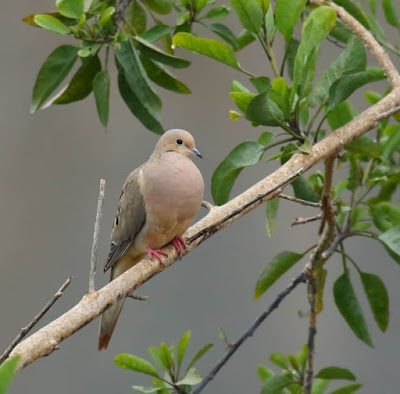 |
| Mourning Dove. Greg Gillson |
Range in Arizona: Mourning Doves are year-round residents throughout Arizona.
Identification: This is a key species for comparing with an unknown bird.
Size: About 12 inches long from bill tip to tail tip. About same size as Northern Flicker. Larger than American Robin. Slightly smaller than domestic city pigeon.
Shape: Very plump with a small round head. Tail is long and pointed. Legs are short.
Bill: Small and rather slender.
Color: Pale brown-pink body, darker wings and tail. White edges on side of tail.
Habitat, range & behavior: Semi-open areas such as urban areas, farmlands, woods.
It is a resident across the lower-48 states and Mexico, with some movement out of northern areas in winter.
Often seen perched on wires, fences. Their mournful cooing is a familiar spring birdsong.
Food and feeder preference: Mourning Doves eat seeds almost exclusively. Attract with black oil sunflower seeds on a large sturdy tray feeder or on the ground.
2. House Finch (Haemorhous mexicanus)
Originally a bird of the West, now commonly found across most of the US. There are other red finches, but these are the ones most likely in residential areas.
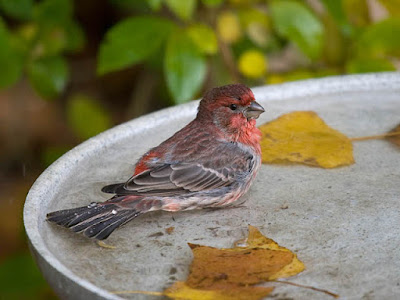 |
| House Finch. Greg Gillson |
Range in Arizona: House Finches are year-round residents throughout Arizona.
Identification: This is a key species for comparing with an unknown bird.
Size: About 6 inches from bill tip to tail tip. Larger than goldfinches and chickadees. Smaller than a White-crowned Sparrows or Spotted/Eastern towhees.
Shape: Medium build with a medium-long notched tail. Round head.
Bill: Short, conical.
Color: Brown and gray above with streaks on the sides of the pale underparts. Males with red (sometimes orange or rarely yellow) crown, chest, rump.
Habitat, range & behavior: You’ll find small flocks on wires, in short treetops and in bushes. Originally deserts and grasslands. Rural areas and towns are where they’re now most common.
Formerly found in the western United States and Mexico. Then introduced into the northeastern United States, but now found in nearly all of the lower-48 states and extreme southern Canada. Rare in plains states (Dakotas to Texas) and southern Florida.
House Finches are not territorial, but males sing throughout the year–a lively, wiry song ending in a couple of buzzy notes.
Food and feeder preference: They love sunflower seeds and tube feeders. May eat from thistle socks.
You may like my in-depth article on attracting House Finches.
3. Gila Woodpecker (Melanerpes uropygialis)
A common woodpecker of the saguaro desert that has become accustomed to backyard bird feeders.
 |
| Gila Woodpecker. Greg Gillson. |
Range in Arizona: Gila Woodpeckers are year-round residents across southern and southwestern Arizona in the Sonoran Desert.
Identification:
Size: Larger than a Starling. Smaller than an American Robin.
Shape: Stout bird with large head. Short tail.
Bill: Long. Chisel-shaped.
Color: Tan body. Black-and-white striped back and wings. White wing patches show in flight. Red crown of male lacking on female.
Habitat, range & behavior: A bird of saguaro deserts. Also found in larger trees along desert streams. Has adapted to live in towns and residential areas.
Range is from Arizona south into western Mexico.
Probes and gleans for food from bark. Does not generally excavate for food as many other woodpeckers do. Excavates nest hole in saguaro cactus.
Food and feeder preference: Insects, also fruits and berries. May drink from hummingbird feeder. Will likely feed on suet.
4. Lesser Goldfinch (Spinus psaltria)
This bird replaces American Goldfinch in the backyard in drier parts of the southwestern US.
 |
| Lesser Goldfinch. Greg Gillson |
Range in Arizona: Lesser Goldfinches are year-round residents in most of Arizona–western, southern, and central Arizona, summer residents only in northeastern Arizona.
Identification:
Size: A small bird. Slightly smaller than American Goldfinch, but close.
Shape: Big head, neckless, short forked tail.
Bill: Short, small, conical.
Color: Green back, yellow underparts including under tail coverts. Black wings and tail with white marks. Male with black cap on forecrown. Keeps the same bright yellow plumage year-round, unlike American Goldfinch.
Habitat, range & behavior: Open scrubby woodlands of oak or other trees, fields, grasslands.
Found in the western and southwestern US, into the Great Basin in summer. Found southward to Middle America.
They sometimes gather into flocks of hundreds to feed in weedy fields.
Food and feeder preference: They eat mostly thistle seeds, some insects. At your feeder they will eat black oil sunflower seeds at a tube feeder but prefer Nyjer seeds in a “thistle sock” feeder.
5. Verdin (Auriparus flaviceps)
This relative of the chickadee is common in desert habitats in the SW United States.
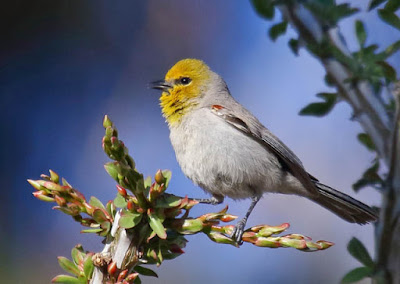 |
| Verdin. Greg Gillson |
Range in Arizona: Verdins are year-round residents in central, southwestern, and southern Arizona.
Identification:
Size: Very small. Just a bit smaller than a chickadee.
Shape: Plump with a medium length rounded tail.
Bill: Short. Straight. Stout.
Color: All gray with a yellow face.
Habitat, range & behavior: Found in desert scrub and thorny shrubs.
California to Texas and south into northern Mexico.
Forages actively on limbs and tips of vegetation in manner of a chickadee.
Food and feeder preference: They eat primarily insects off of shrubbery. They are not attracted to seed feeders nor have they been documented to drink fresh water! They may drink sugar water from oriole nectar feeders.
6. Anna’s Hummingbird (Calypte anna)
This big resident hummingbird is common in the far West everywhere there are people!
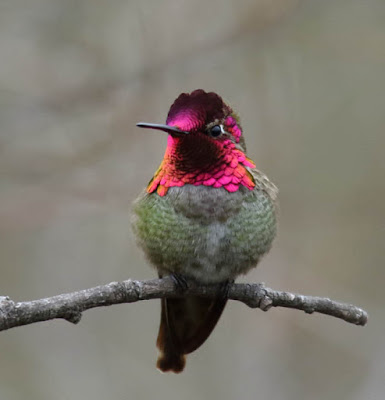 |
| Anna’s Hummingbird. Greg Gillson |
Range in Arizona: Anna’s Hummingbirds are year-round residents in western, central, and southwestern Arizona, winter visitors only in southeastern Arizona.
Identification:
Size: Slightly larger than widespread hummingbirds like Ruby-throated in the east and Rufous Hummingbird in the west. Smaller than a goldfinch or chickadee.
Shape: Plump, with long wings covering tail. Unmistakable long bill.
Bill: Longer than head, round, slightly downcurved.
Color: Green upper parts, gray under parts with greenish cast on sides. Male with entire head and throat covered in iridescent metallic rose pink. Female usually has pink throat spot.
Habitat, range & behavior: Chaparral, open woods, suburban gardens all host this species.
Formerly only in northern Baja and southern California they expanded to Arizona, and all the way to southern Alaska along the Pacific coast, following plantings of winter blooming flowers and the popularity of placing out hummingbird feeders.
Nest early (December to February), even as they move north and encounter snow in winter.
Food and feeder preference: Nectar and small insects is their main food. Both are available in flowering plants. Quickly find hummingbird feeders filled with sugar water.
7. White-crowned Sparrow (Zonotrichia leucophrys)
A common winter visitor to backyards and weedy road edges.
 |
| White-crowned Sparrow. Greg Gillson |
Range in Arizona: White-crowned Sparrows are winter visitors throughout Arizona, year-round residents in a small area of north-central Arizona.
Identification: This is a key species for comparing with an unknown bird.
Size: About 7 inches. A large sparrow near size of Spotted/Eastern towhee. Larger than House Finch. Smaller than Starling or Red-winged Blackbird.
Shape: Longer plump body, round head, long tail.
Bill: Short and conical.
Color: Brown back, wings, tail, gray under parts, black-and-white striped crown. For their first-year immature birds have tan and reddish-brown striped crowns.
Habitat, range & behavior: Open and shrubby areas.
Coastal form in California at edge of sand dunes. Common winter form in California breeds on Arctic tundra. Various forms breed across the Arctic Canada and Alaska and in mountains in western Canada and the United States.
They sing in spring migration as they move northward. Different populations have slightly different songs.
Food and feeder preference: Weed seeds, grain, insects. Eat black oil sunflower seeds and other seeds on hopper and tray feeders.
8. Yellow-rumped Warbler (Setophaga coronata)
An abundant winter visitor in the southern US to treetops and weedy areas.
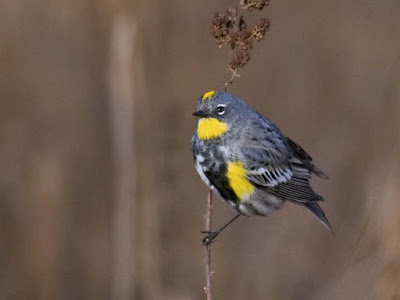 |
| Yellow-rumped Warbler. Greg Gillson |
Range in Arizona: Yellow-rumped Warblers are year-round residents in southeastern Arizona, summer residents in northeastern Arizona, and winter visitors only in western Arizona.
Identification:
Size: Small, they are a bit larger than chickadees and goldfinches. They are smaller than House Finches and juncos.
Shape: Plump and neckless with a shorter tail.
Bill: Short, slender, straight, pointed.
Color: Breeding plumage in spring is blue-gray on the upper parts, black sides and chest, yellow rump, yellow on sides. Two forms: western form with yellow throat and large white wing patch; eastern and northern form with white throat and two white wing bars. In winter plumage both forms are gray-brown above, pale cream below. Yellow rump and white tail corners in flight.
Habitat, range & behavior: In breeding season mostly in coniferous or mixed forests, in mountains in west. In winter open areas with fruiting shrubs and scattered trees.
Breed across Canada and Alaska and in conifer forests in the west. Winter along both coasts and the southern states through Middle America.
There are also non-migratory forms in Mexico and Guatemala. They tend to forage in outer branches about half way up the tree.
Food and feeder preference: Mainly insects in the summer, they switch to waxy berries and fruit in winter. They are thus able to winter farther north than other warblers. They are attracted to suet feeders.
9. White-winged Dove (Zenaida asiatica)
This desert dove can be locally common in desert towns.
 |
| White-winged Dove. Greg Gillson |
Range: White-winged Doves are summer residents in southwestern and southeastern Arizona, year-round residents in south-central Arizona.
Identification:
Size: A bit larger than a Mourning Dove.
Shape: A more muscular neck than Mourning Dove. A square tail.
Bill: Short and slender.
Color: Brown with black under tail base and broad white tip. White wing patches in flight, also visible when perched.
Habitat, range & behavior: Desert thickets, saguaro cacti and towns.
Found in the southwestern United States, Middle American, and West Indies.
They often seek water in the morning and afternoon.
Food and feeder preference: They eat seeds, grain, and fruit of the saguaro cactus. They are more likely to feed on a raised platform feeder than on the ground. They will eat black oil sunflower seeds and cracked corn.
10. Curve-billed Thrasher (Toxostoma curvirostre)
Widespread desert bird that is commonly found in backyards in the Southwest.
 |
| Curve-billed Thrasher. Greg Gillson. |
Range in Arizona: Curve-billed Thrashers are year-round residents in southwestern and southern Arizona.
Identification:
Size: A larger bird. Longer than an American Robin, slightly shorter than a Mourning Dove.
Shape: Rather long and thin with short neck and ample tail.
Bill: Slender, fairly long, slightly curved.
Color: Rather dusky brown throughout. More easterly populations have pale under parts with dark spotting. Western populations are more uniform brown. Pale orangish eye.
Habitat, range & behavior: Especially favors cholla cactus, and is found in residential areas where this cactus is present.
Widespread in the desert Southwest, both in Sonoran Desert of Arizona and Chihuahuan Desert of West Texas. Also, from Colorado south through Mexico.
Feeds mostly on the ground underneath desert shrubs and cacti. Runs from bush to bush across open ground.
Food and feeder preference: Omnivore, eats invertebrates, berries, and fruits from cactus. They will visit backyard bird feeders. They may eat seeds but enjoy suet and mealworms. They also take advantage of birdbaths.
11. Gambel’s Quail (Callipepla gambelii)
A desert bird that may visit backyards on the edge of town.
 |
| Gambel’s Quail. Greg Gillson |
Range in Arizona: Gambel’s Quail are year-round residents in western, south-central, and southern Arizona.
Identification:
Size: Actually, only as long as an American Robin. Shorter, bill to tail, than Mourning Dove, though much differently shaped.
Shape: Round and plump with strong breast and legs. Relatively small head. Short tail.
Bill: Short, stout. Culmen decurved.
Color: Blue-gray chest. Cream belly with dark central patch. Back and tail brownish. Rusty streaked flanks. Chestnut crown. Two ornamental feathers drooping over forehead.
Habitat, range & behavior: Found in brushy and thorny desert scrub.
Ranges in SW deserts from Colorado south to west Texas and California into NW Mexico.
Forage on the ground in flocks. Run from danger.
Food and feeder preference: Nearly all food is plants: seeds, leaves, berries. Mesquite tree pods are a favorite food. They may visit a low platform feeder or seed scattered on the ground. They will eat sunflowers, millet, cracked corn, and are one of a few birds that will eat milo–a common filler seed in cheap birdseed. Will come to water on the ground.
12. Great-tailed Grackle (Quiscalus mexicanus)
A big, noisy bird often found near water and in urban landscapes.
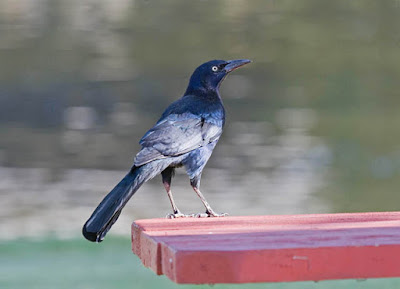 |
| Great-tailed Grackle. Greg Gillson |
Range in Arizona: Great-tailed Grackles are year-round residents throughout Arizona.
Identification:
Size: Large bird. Males about the size of a crow; females smaller but still as large as a Mourning Dove.
Shape: Long and slender with a big full tail.
Bill: Long, pointed, stout.
Color: Glossy black with purplish highlights. Females browner.
Habitat, range & behavior: Shorelines, golf courses, agricultural areas, urban centers.
Found in southern portions of West and Midwest US south through Central America.
Forage on the ground. Social and loud, with squeaky calls and whistles.
Food and feeder preference: Omnivorous–insects, fruits, human food scraps. To keep these obnoxious birds away from your feeders never feed birds human food wastes.
13. Abert’s Towhee (Melozone aberti)
These desert towhees have a very restricted range.
 |
| Abert’s Towhee. Greg Gillson. |
Range in Arizona: Abert’s Towhees are year-round residents in western, south-central, and southeastern Arizona.
Identification:
Size: Similar to White-crowned Sparrow and other towhees. Smaller than Americna Robin.
Shape: Plump. Large round head. Full tail.
Bill: Large and conical.
Color: They are dusty brown with dark cinnamon under tail. Black face around bill and eyes.
Habitat, range, & behavior: Desert stream sides with willow and cottonwoods. Residential landscapes.
General range is along the Colorado River from southwest Utah, southern Nevada, to Mexico. From there across south-central Arizona and barely into southwestern New Mexico.
They scratch for food in leaf litter under bushes.
Food and feeder preference: Their diet is mostly insects. Water is a bigger draw to backyards than seeds.
14. House Sparrow (Passer domesticus)
Like the starling, this is another bird introduced from Europe in the 1800’s. This sparrow is commonly found in cities and farmlands. It is considered a pest in most areas where it has been introduced.
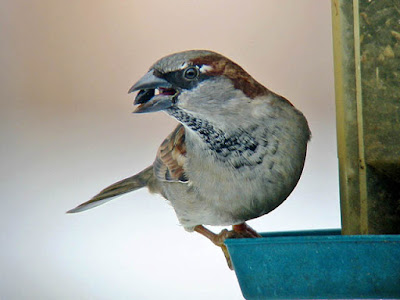 |
| House Sparrow. Greg Gillson |
Range in Arizona: House Sparrows are year-round residents throughout Arizona.
Identification:
Size: The size of a House Finch or Dark-eyed Junco.
Shape: Chunkier than native North American sparrows with large head, barrel chest, short neck, medium tail, short legs.
Bill: Short, conical.
Color: Males are brown and gray with a black mask. Females lack the black and are tan and brown with a pale line back from the eye.
Habitat, range & behavior: Cities and farms.
Range in North American from southern Canada through Central America. In summer northward through Canada to southern Alaska. Originated in Middle East and spread to most of Europe and Asia. Introduced in South America, Africa, Australia–nearly anywhere there are people and cities.
They tend to be messy… and have a good appetite and may occur in large noisy chirping flocks. They are aggressive toward other feeder birds.
Food and feeder preference: They eat grain, seed, and insects. To discourage them from your hopper and tray feeders do not feed birds human food scraps. They have a bit of difficulty eating from tube feeders.
15. Northern Mockingbird (Mimus polyglotos)
This bird sings from exposed perches most of the year and often through the night. They have an unending supply of their own unique short phrases that they repeat about 3 times each, but frequently intersperse songs of other birds.
 |
| Northern Mockingbird. Greg Gillson. |
Range in Arizona: Northern Mockingbirds are year-round residents throughout Arizona.
Identification:
Size: The length of an American Robin.
Shape: Slender and long tailed. Long legs.
Bill: Medium length, slender, slightly curved.
Color: Gray, darker above, with white patches in wing and tail.
Habitat, range & behavior: They prefer edge habitat with scattered trees and bushes, parks and residential areas.
They are found in eastern and southern parts of the US, West Indies, and south into Mexico.
They boldly defend their nests from other birds, cats, and intruders.
Food and feeder preference: Northern Mockingbirds eat insects, berries, and fruit. You may attract mockingbirds to your feeder with grapes, raisins, apple slices. They will come to a suet block. They readily use a bird bath.
16. Eurasian Collared-Dove (Streptopelia decaocto)
These large pale pigeons have only been in the United States since invading Florida in 1983. But they have taken over much of the continent and become very common birds in many locations.
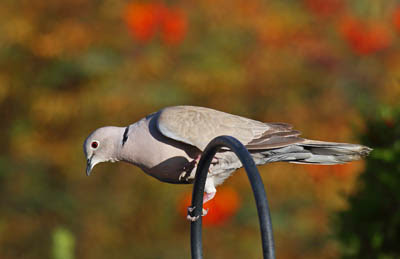 |
| Eurasian Collared-Dove. Greg Gillson. |
Range in Arizona: Eurasian Collared-Doves are year-round residents throughout Arizona.
Identification:
Size: Large pigeon. Larger than Mourning Dove. Same size as domestic pigeon.
Shape: Full plump breast. Round head. Long square tail.
Bill: Small.
Color: Cream-colored, may be slightly warmer brown on back or, conversely, may be nearly white. Black hind neck mark. Broad white band at end of tail. From underneath when perched on wire, note the black base to the underside of the tail.
Habitat, range & behavior: These pigeons are found in residential areas and farmlands. Look for them perched on electric lines or in trees.
They are year-round residents in residential areas throughout almost all of the United States, except rare in the Northeast.
A pair of birds nest in one area nearly year-round, then build in numbers over a couple of years. Then several birds from the group fly up to 500 miles and set up a new colony. In this way this species took over much of Europe in the last century, and most of North America, starting from Florida in 1983 (from birds escaped from or vagrant in Bahamas).
Food and feeder preference: Eat grain. Will eat all seeds at bird feeders. Large, hungry, and often visit feeders in groups.
17. Ladder-backed Woodpecker (Dryobates scalaris)
This black-and-white striped woodpecker is common in desert habitats.
 |
| Ladder-backed Woodpecker. Greg Gillson. |
Range in Arizona: Ladder-backed Woodpeckers are year-round resident in western, central, and southern Arizona.
Identification:
Size: A small woodpecker. Larger than a House Finch. Smaller than an American Robin. A bit larger than a Downy Woodpecker.
Shape: Stocky body. Large head. Short, pointed tail. Stong feet.
Bill: As long as head. Chisel shaped.
Color: Black-and-white striped back and wings. White under parts with spotting. White face with black stripes. Male with red crown.
Habitat, range & behavior: Found in deserts. Frequents mesquite, ocotillo, cholla cactus, and even pinyon-juniper woodlands.
Found from California to Texas and south through Mexico.
Crawl up and around branches and stay hidden with a tree or shrub.
Food and feeder preference: Their diet is mostly insects they pick from bark. Not easily attracted to feeders but may eat sunflower seeds and suet.
18. Black Phoebe (Sayornis nigricans)
This perky little flycatcher should be familiar to most Southwestern residents.
 |
| Black Phoebe. Greg Gillson. |
Range in Arizona: Black Phoebes are year-round residents in western, central, and eastern portion of southern Arizona. They are summer residents in northeastern and southern part of eastern Arizona. And they are winter visitors only in southwestern Arizona.
Identification:
Size: About the size of a White-crowned Sparrow or Spotted/Eastern towhee. Bigger than a House Finch. Much smaller than a European Starling.
Shape: Big peaked head, pot belly, long slender tail.
Bill: About half the length of the head, straight, very wide.
Color: Sooty black upper parts and upper breast. White belly.
Habitat, range & behavior: Found in lowlands near water, extensive lawns, and grassy backyards.
Found in the western United States, most of Mexico, south into northern and western South America.
May build their mud nests on porches or outbuildings. Typical flycatching behavior: sitting still, then sallying out to grab a flying insect, and return to a perch with a bob of the tail.
Food and feeder preference: Black Phoebes eat flying insects that they chase low over the lawn in aerial pursuits. They don’t eat at bird feeders, but they need your bird bath to make mud for their nests.
19. Ruby-crowned Kinglet (Regulus calendula)
These tiny little hyperactive balls of feathers are very similar in appearance to sluggish Hutton’s Vireos. Note the yellow feet and skinny black legs of the kinglet. Common in backyards in winter.
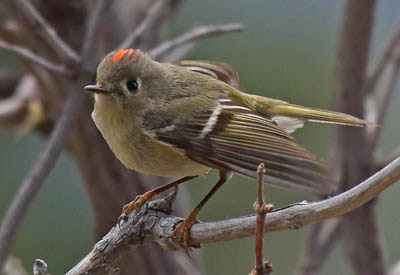 |
| Ruby-crowned Kinglet. Greg Gillson. |
Range in Arizona: Ruby-crowned Kinglets are year-round residents in eastern and northeastern Arizona, and winter visitors throughout.
Identification:
Size: Smaller than a chickadee or goldfinch.
Shape: Plump, almost round body with round head merging into the body almost without neck. Very short tail. Thin legs.
Bill: Very short, rather thin.
Color: Olive-green, tending toward gray, especially on the head. Paler yellow-green below. Wing gray with yellow-green edges to the wing feathers. Two white wing bars with distinctive black panel below the lower wing panel. White eye ring slightly broken on top and bottom. Red crown of male only shows when agitated. Legs very thin, black, with obvious yellow soles to the feet.
Habitat, range, and behavior: Mountain conifers in summer, brushy patches and chaparral in winter. Residential landscaping hedges and bushes.
Breeds in Alaska, across Canada, and mountains of the West. Migrates through all of US. Winters in coastal East, Southeast, West, into Mexico.
Active flitting from branch to branch, in interior of bushes and small trees, in short flap-hops. Constantly twitches wings. Hover-gleans at leaf tips.
Food and feeder preference: Ruby-crowned Kinglets feed in bushes next to house looking for spiders and insects. May eat at suet feeder.
20. Say’s Phoebe (Sayornis saya)
This western flycatcher is often found around ranches and canyons.
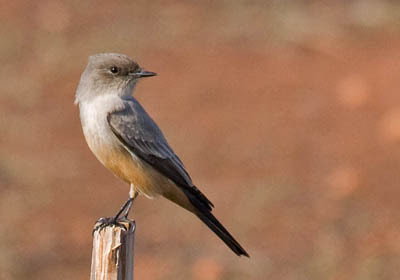 |
| Say’s Phoebe. Greg Gillson. |
Range in Arizona: Say’s Phoebes are year-round residents in western, southern, and central Arizona, summer residents in northeastern Arizona.
Identification:
Size: About the size of a White-crowned Sparrow. Larger than a House Finch, smaller than a Red-winged Blackbird or European Starling.
Shape: Large partially crested head, upright posture, long full tail.
Bill: Rather small and flat. Black.
Color: Upper parts are gray-brown. Under parts are cinnamon. Tail dark.
Habitat, range, and behavior: Found in dry, open country, grasslands, deserts.
Year-round resident in Mexico and the Southwest. Summers widely in the West and Great Plains to Alaska. Winters more widely in Southwest and Mexico.
Perch on roofs, fence lines, small trees, or ground and chases insects low to the ground.
Food and feeder preference: Eat insects. Do not come to feeders.
21. Northern Cardinal (Cardinalis cardinalis)
This is one of the most common and popular backyard birds in the eastern half of the United States. Surprise! There is a population in the Desert Southwest, too.
 |
| Northern Cardinal. Greg Gillson. |
Range in Arizona: Northern Cardinals are year-round residents in central and southeastern Arizona.
Identification:
Size: Cardinals are a bit smaller than American Robins, about the same size as Red-winged Blackbirds.
Shape: Plump body with fairly long full tail. Wispy crest.
Bill: Short, heavy, conical, pink.
Color: That bright red color is matched by few other birds. Black face. The female is grayer, but with hints of red in wings and tail, and has a crest, too.
Habitat, range & behavior: Cardinals are year-round residents in shrubby woodland edges from the eastern United States to Texas and Arizona south into Mexico.
That large conical bill is made for chewing seeds. Watch them crack open sunflower seeds, spit out the hulls, and pluck the kernel with their tongues!
Food and feeder preference: Black oil sunflower seeds. Many types of seeds, berries, nuts in larger hopper or tray feeders.
You may like my in-depth article on attracting Northern Cardinals.
22. Cactus Wren (Campylorhynchus brunneicapillus)
These birds are found in cholla cactus stands and other prickly bushes. The more spines the better!
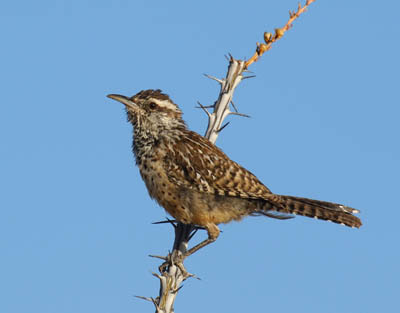 |
| Cactus Wren. Greg Gillson. |
Range in Arizona: Cactus Wrens are year-round residents in western, central, and southern Arizona, absent in northeastern Arizona.
Identification:
Size: Large wren. The size of a towhee or fat White-throated Sparrow. Smaller than a Red-winged Blackbird.
Shape: Chunky body. Large head. Long tail. Long legs.
Bill: As long as head. Downcurved and pointed.
Color: Brown, gray, and black barred upper parts and tail. Head with rusty crown and stripe through eye. White eyebrow stripe. Gray chest with cinnamon wash over belly and lots of black spots.
Habitat, range & behavior: They live in cholla and prickly pear cacti patches.
They are found from southeastern California to central Texas and south through Baja and central Mexico.
They are very active and noisy. They poke around cacti and frequently perch high to sing.
Food and feeder preference: Their diet is mostly spiders and insects. You can attract them to your feeder with sunflower seeds and suet.
23. Northern Flicker (Colaptes auratus)
This ant-eating woodpecker spends a lot of time hopping and probing on the ground. This behavior confuses many beginners who don’t know what to make of the long bill, red wing linings, and white rump. When the males drum loudly on their downspouts at dawn in spring, then they know it’s a woodpecker!
 |
| Northern (Red-shafted) Flicker. Greg Gillson. |
Range in Arizona: Northern Flickers are resident in northern Arizona, absent or rare winter visitors in southern Arizona.
Identification:
Size: About the size of a Mourning Dove. Larger than a robin.
Shape: Stocky with short legs, short tail, big head.
Bill: As long as head, thin, slightly curved.
Color: Back is brown with black bars. Under parts pinkish with black spots. Undersides of black wing and tail feathers are bright salmon red (West) or yellow (East). Head gray (West) or brown (East) and males with red (West) or black (East) whisker marks and nape marks (East). Black crescent across chest. White rump seen in flight.
Habitat, range & behavior: Found in woodland edges and forests.
Year-round resident from extreme southern Canada, across all of the lower-48 states and in the mountains of Mexico and Middle America. In summer breeds northward well into Canada and Alaska.
Frequently noted hopping on ground pecking in the ground for insects. In late spring, males proclaim their territory by rapid pounding on a hollow tree branch, though the ringing of metal downspouts at dawn is louder and carries much farther to the exasperation of anyone trying to sleep inside!
Food and feeder preference: Ants and beetles are their primary foods. Will eat black oil sunflower seeds and are attracted to suet.
24. Phainopepla (Phainopepla nitens)
These sleek crested birds are my favorite desert birds.
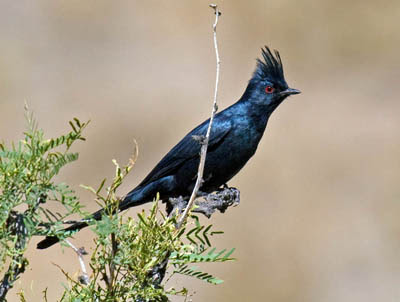 |
| Phainopepla. Greg Gillson. |
Range in Arizona: Phainopeplas are year-round residents in southeastern Arizona, summer residents in central and northwestern Arizona, and winter visitors in southwestern Arizona. They are absent from northeast Arizona.
Identification:
Size: A bit larger than White-crowned Sparrow. Smaller than Northern Mockingbird.
Shape: Long and thin. Long rounded tail. Wispy tall crest.
Bill: Small, short.
Color: Males are glossy black with red eyes and white wing patches. Females are soft gray and lack the wing patches.
Habitat, range & behavior: Mesquite, palo verde and other trees in deserts, also oak woodlands.
Found from central California to west Texas and south into Mexico.
Often fly over the desert with deep fluttery wing strokes, displaying large white patches in the wing of males. They perch high in treetops. Sometimes group together, though often just stay in pairs.
Food and feeder preference: Their diet is mostly fruit–especially berries of desert mistletoe. They also eat insects. Do not come to feeders.
25. European Starling (Sturnus vulgaris)
Introduced to North America in the late 1800’s, they crossed the continent, often to the detriment of native cavity-nesting birds. The prime example of an invasive species.
 |
| European Starling. Greg Gillson. |
Range in Ariona: European Starlings are year-round residents throughout Arizona.
Identification:
Size: About the size of a Red-winged Blackbird. Smaller than an American Robin. Larger than a White-crowned Sparrow or Spotted/Eastern towhee.
Shape: Stocky with large head, short square-ended tail. Longer legs.
Bill: As long as head. Sharp pointed. Yellow in spring, otherwise dark.
Color: They are grayish brown much of the year, with glossy iridescence and white spotting during the spring.
Habitat, range & behavior: Lowland birds that need trees large enough for nest cavities but plenty of open area for feeding. They are most abundant in urban and suburban areas where they find food and artificial nest cavities.
Resident from coast-to-coast from southern Canada to northern Mexico. In summer north across Canada and Alaska. Native range is Europe to Pakistan, north Africa.
Often viewed as a pest, starlings often bully other backyard birds, taking over bird feeders, and stealing nest cavities from smaller native birds.
In winter they can form into flocks of tens of thousands.
Food and feeder preference: European Starlings eat primarily insects when available, often feeding on the ground. Discourage them from your backyard hopper and tray feeders by never feeding birds table scraps (including bread or meat). They have weak feet and do not perch well on tube feeders. A cage mesh around smaller hopper feeders may keep them out.
26. Vermilion Flycatcher (Pyrocephalus rubinus)
The striking red males are an amazing sight. The scientific name translates to red fire-head.
 |
| Vermilion Flycatcher. Greg Gillson. |
Range in Arizona: Vermilion Flycatchers are year-round residents in southeastern Arizona, summer residents in central Arizona.
Identification:
Size: Small. About the same size as a House Finch.
Shape: Round body. Big puffy head. Medium-short tail.
Bill: Rather short, wide in head-on view.
Color: Males are strikingly red on the head and underparts. A dark brown mask connects to the nape and back. The shoulders and tail are also dark. Females are gray above, including the crown of the head, pale below with streaks, soft yellowish or peach-colored wash on belly.
Habitat, range & behavior: Found in open desert country, especially near streams. Frequent golf courses, grassy parks. May sit on low wires, fence posts.
Found from southern California to central Texas and into Mexico. Winters along Gulf Coast to Florida.
Sit on low perch and fly out to chase insects low along ground.
Food and feeder preference: Diet is flying insects. Do not come to feeders.
27. Bewick’s Wren (Thryomanes bewickii)
This is a brush-loving bird that may hide in your backyard hedges.
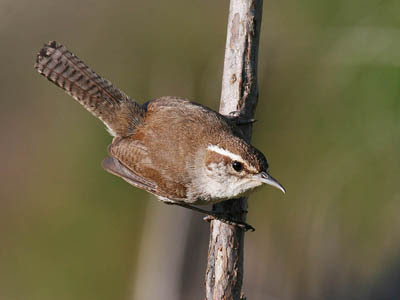 |
| Bewick’s Wren. Greg Gillson. |
Range in Arizona: Bewick’s Wrens are year-round residents throughout most of Arizona, absent in the Sonoran Desert of southwestern Arizona.
Identification:
Size: These are fairly small birds, about the size of House Finches.
Shape: They are rather stocky, with short neck, long floppy tail, fairly long legs.
Bill: Long, thin, slightly curved.
Color: Different populations can be more gray or brown. Barred brown and black tail. Pale gray under parts. The white eyebrow is diagnostic.
Habitat, range, and behavior: These birds are found in brushy tangles, chaparral, backyard bushes.
These birds live along the West Coast from southern British Columba southward into Mexico, the Southwest, east to Missouri.
They stay hidden in dense brush except in spring when they sing loudly from exposed perches.
Food and feeder preference: Bewick’s Wrens eat primarily insects and invertebrates. They will come to feeders in winter for suet.
28. White-breasted Nuthatch (Sitta carolinensis)
A favorite feeder bird for many for its active antics and fearlessness. Though a small bird it is the largest nuthatch in North America.
 |
| White-breasted Nuthatch. Greg Gillson |
Range in Arizona: White-breasted Nuthatches are year-round residents in central, northeastern, and eastern Arizona.
Identification:
Size: About chickadee-sized in length. Smaller than a junco or House Finch.
Shape: Appears large-headed, neckless, very short tailed. Short legs.
Bill: Nearly as long as head, straight, thin.
Color: Blue-gray above, white below. Black cap, wing tips, tail. Rusty feathers under tail.
Habitat, range & behavior: Common in oak and oak-pine woodlands, wooded towns.
Found across the United States, southern Canada, mountains of central Mexico. Absent from treeless grasslands, deserts in the west.
Crawls over tree branches and head-first down tree trunks searching for insects.
Food and feeder preference: Insects, seeds, acorns and other nuts. Love black oil sunflower seeds feeding on hopper and tray feeders. Suet blocks.
29. Red-winged Blackbird (Agelaius phoeniceus)
These noisy flocking birds are most often found in marshes. But in winter they are found in backyards.
 |
| Male Red-winged Blackbird. Greg Gillson. |
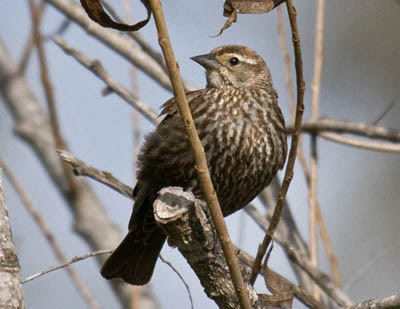 |
| Female Red-winged Blackbird. Greg Gillson. |
Range in Arizona: Red-winged Blackbirds are year-round residents throughout Arizona.
Identification: This is a key species for comparing with an unknown bird.
Size: About 8-3/4 inches long from bill tip to tail tip. About the size of a Northern Cardinal. Smaller than an American Robin.
Shape: Pot-bellied with a longer bill and flat forehead. Tail average.
Bill: Long and sharp pointed.
Color: Males are black with red and yellow shoulder patch. Females are streaked brown and rusty (sparrow-like but pointed bill and flat forehead).
Habitat, range, and behavior: Cattail marshes and wetlands are their summer habitat. In winter they feed in grain fields.
They breed across most of the North American continent. In winter they withdraw from most of Alaska and Canada.
They are found in colonies in summer and large flocks in winter.
Food and feeder preference: They eat insects in summer. In winter they eat grain and seeds. They visit feeders, more often in large winter flocks, and eat most seeds and suet.
30. Dark-eyed Junco (Junco hyemalis)
Colloquially called “snowbirds,” they often arrive in backyards in winter from nearby mountain forests or more northern climes.
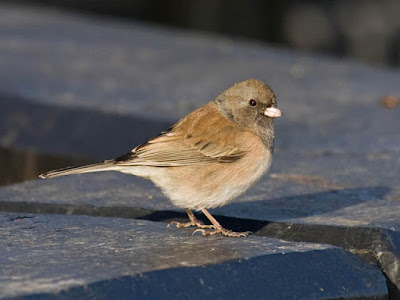 |
| Dark-eyed Junco. Photo by Greg Gillson. |
Range in Arizona: Dark-eyed Juncos are year-round residents in northern and northeastern Arizona, winter throughout.
Identification:
Size: Small birds about the size of a House Finch.
Shape: Round body, short neck, round head, fairly long square-ended tail.
Bill: Short, pointed, conical, pink.
Color: Eastern birds are a darker all-gray with white belly. Western birds (those breeding in California and pictured above) have jet black hood over the head, brown back, white belly and pink sides. Females paler.
Habitat, range & behavior: Breed in coniferous forests. Winters widely. Avoids heavy brush, preferring widely spaced bushes.
Breeds across most of Canada, Alaska, and the western half of the United States. Winters from southern Canada and all of the lower 48-states to extreme northern Mexico.
Spend much of their time hopping and feeding on the ground.
Food and feeder preference: Dark-eyed Juncos eat mostly seeds, also insects in summer. Readily feed at backyard feeders on mixed seeds on hopper or tray feeders and ground.
You may like my in-depth article on attracting Dark-eyed Juncos.
31. Brown-headed Cowbird (Molothrus ater)
Cowbirds are small blackbirds lay their eggs in the nests of other smaller birds, such as warblers. The adoptive parents raise their young!
 |
| Brown-headed Cowbird. Greg Gillson. |
Range in Arizona: Brown-headed Cowbirds are summer residents throughout Arizona, year-round residents in southeastern Arizona.
Identification:
Size: Larger than White-crowned Sparrows, but smaller than Rose-breasted or Black-headed Grosbeaks. Smaller than other blackbirds, starlings, and grackles.
Shape: Perhaps a little bit pot-bellied. Medium length tail. Flat forehead as typical for blackbirds.
Bill: Rather thick and stout.
Color: Males are glossy black with rich brown head. Females are dusty gray-brown throughout. Long-held juvenile plumage similar to pale female, scaly, being fed by Yellow Warbler or Song Sparrow or a hundred other host species.
Habitat, range & behavior: They are found in woodlands and farms. Also, with other blackbirds in winter at shopping center parking lots.
In summer they breed across Canada and most of the United States and Mexico. In winter they move south out of Canada and occupy both coasts and southeastern States in the US.
These small blackbirds join other flocks of blackbirds in cattle feedlots. You may see cowbirds riding on the backs of cattle, sheep, or horses. They originally rode on the backs of American bison on the Great Plains but expanded when forests were cut.
Food and feeder preference: Cowbirds eat grains, seeds, and insects. They will readily come to hopper and platform feeders. They are larger and more aggressive, so keep other birds from feeders and have a big appetite!
32. Black-chinned Hummingbird (Archilochus alexandri)
The throat feathers of all male hummingbirds are black. Only when light is refracted at just the right angle do those brilliant gemstone colors appear. For this species, however, the throat appears black all the time, except for some deep purple feathers at the bottom of the gorget.
 |
| Black-chinned Hummingbird. Greg Gillson. |
Range in Arizona: Black-chinned Hummingbirds are summer residents throughout most of Arizona, spring and fall migrants only in southwestern Arizona.
Identification:
Size: Tiny.
Shape: Round body with large head and not much neck. Tail fairly long for a hummingbird. Long wings don’t quite extend to tail tip when perched. Long needle-like bill.
Bill: Long tubular, slightly downcurved.
Color: Green above and crown. White below with dusky green sides. White wraps up part way around neck like a collar, strongly contrasts with dark throat of male. Female has white throat, gray crown.
Habitat, range & behavior: River canyons, arid areas. Sycamores, oaks.
Summer residents in deserts of the West and Southwest from interior British Columbia south through California and Texas.
Food and feeder preference: They eat insects and spiders, flower nectar. Readily come to hummingbird feeders.
Common Birds in Arizona
To determine how common each species is I used the data from actual bird sightings from the citizen science program eBird. Birds are listed by frequency. That is, how often the species is recorded on checklists submitted to eBird (a percentage).
When choosing the birds to include in this article I leaned strongly to birds that are present throughout the year in good numbers. Thus, many of the common birds are year-round residents. This means that they live in the same location all year. They raise their young in your neighborhood. They don’t migrate. Or if the species does migrate, the ones living in your area don’t. If this is the case, some migrants may move into your area during certain times of year, adding to the same species that are in your yard full time.
Some migrant birds visit your yard during the “summer.” Often, they arrive in spring and remain until late fall. They nest and raise their young in your neighborhood. These are the summer residents.
Other migrant birds visit your backyard during the “winter.” Some of these winter visitors may arrive in July and remain into April. Others may only be found in the cold of December or January. They key here is that they nest and raise their young somewhere else. They only visit your yard in the non-breeding season.
Migration is an amazing spectacle.
There will be birds that fly through your region in spring or fall (or both). They may visit your backyard only a few days or weeks a year. They aren’t regular enough, or stay long enough, to be included in this article. But the number of briefly visiting migrant birds could double the number of species presented here. You may see them over time. Consult checklists in eBird for your county to see what is possible.
I have generally excluded common waterfowl, birds of prey, shorebirds, seabirds, and others that aren’t usually found in residential areas. But they may certainly fly over or be seen regularly if your home is on a shoreline, for instance.
Most common backyard birds in Arizona throughout the year
The following list is the backyard birds that are, on average, most common throughout the entire year. The list is ordered by most common based on the frequency of how often each species is recorded on checklists submitted to eBird.
- Mourning Dove (46% frequency)
- House Finch (45%)
- Gila Woodpecker (35%)
- Lesser Goldfinch (31%)
- Verdin (30%)
- Anna’s Hummingbird (24%)
- White-crowned Sparrow (23%)
- Yellow-rumped Warbler (23%)
- White-winged Dove (22%)
- Curve-billed Thrasher (22%)
- Gambel’s Quail (21%)
- Great-tailed Grackle (21%)
- Abert’s Towhee (20%)
- House Sparrow (20%)
- Northern Mockingbird (18%)
- Eurasian Collared-Dove (16%)
- Ladder-backed Woodpecker (16%)
- Black Phoebe (16%)
- Ruby-crowned Kinglet (16%)
- Say’s Phoebe (15%)
- Northern Cardinal (15%)
- Cactus Wren (15%)
- Northern Flicker (15%)
- Phainopepla (14%)
- European Starling (14%)
- Vermilion Flycatcher (14%)
- Bewick’s Wren (14%)
- White-breasted Nuthatch (14%)
- Red-winged Blackbird (13%)
Most common backyard birds in Arizona in winter
The following list is the backyard birds that are most common in winter. The list is ordered by most common based on the frequency of how often each species is recorded on checklists submitted to eBird.
- House Finch (47% frequency)
- Mourning Dove (43%)
- Gila Woodpecker (40%)
- White-crowned Sparrow (37%)
- Verdin (33%)
- Yellow-rumped Warbler (33%)
- Ruby-crowned Kinglet (28%)
- Anna’s Hummingbird (28%)
- Lesser Goldfinch (25%)
- Abert’s Towhee (24%)
- Curve-billed Thrasher (23%)
- Great-tailed Grackle (21%)
- Say’s Phoebe (21%)
- Black Phoebe (20%)
- House Sparrow (20%)
- Dark-eyed Junco (20%)
Most common backyard birds in Arizona in summer
The following list is the backyard birds that are most common in summer (June and July). The list is ordered by most common based on the frequency of how often each species is recorded on checklists submitted to eBird.
- Mourning Dove (46% frequency)
- House Finch (43%)
- White-winged Dove (42%)
- Lesser Goldfinch (31%)
- Gila Woodpecker (26%)
- Verdin (24%)
- Gambel’s Quail (21%)
- Brown-headed Cowbird (20%)
- Black-chinned Hummingbird (20%)
How do the birds in winter differ from the birds in summer?
In winter White-crowned Sparrows, Yellow-rumped Warblers, Ruby-crowned Kinglets are more common.
In summer most birds are less common. No doubt they are more local to towns and other places with water, and not so widespread as in winter.
White-winged Doves are much more common, however, in Arizona in summer as compared to winter.
Common backyard birds of Phoenix, Arizona
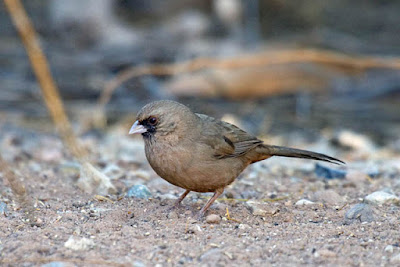 |
| Abert’s Towhee. Greg Gillson |
- Mourning Dove (65% frequency)
- Great-tailed Grackle (54%)
- House Finch (52%)
- Verdin (52%)
- Gila Woodpecker (50%)
- Anna’s Hummingbird (41%)
- Curve-billed Thrasher (40%)
- Abert’s Towhee (40%)
- European Starling (39%)
- Northern Mockingbird (39%)
- House Sparrow (38%)
- Gambel’s Quail (35%)
- Rock Pigeon (33%) Learn about this species on eBird
- Eurasian Collared-Dove (32%)
- Yellow-rumped Warbler (29%)
- White-crowned Sparrow (25%)
- Black Phoebe (24%)
- White-winged Dove (23%)
- Say’s Phoebe (21%)
Because of the water and bird feeders, most backyard birds in the Phoenix area are much more common than in the rest of this desert state. Birds that appear as common in Phoenix that aren’t nearly so in the rest of the state are Abert’s Towhee, plus the urban birds: European Starling, Rock Pigeon, Eurasian Collared-Dove.
An exception to this is that Lesser Goldfinch is less common in the Phoenix area (18% frequency) than in the state as a whole (31%).
Common Backyard Birds of Tucson, Arizona
- Mourning Dove (54% frequency)
- House Finch (50%)
- Gila Woodpecker (48%)
- Verdin (45%)
- Lesser Goldfinch (37%)
- Anna’s Hummingbird (27%)
- Curve-billed Thrasher (26%)
- White-winged Dove (25%)
- Cactus Wren (24%)
- Abert’s Towhee (24%)
- Gambel’s Quail (24%)
- Vermilion Flycatcher (24%)
- White-crowned Sparrow (23%)
- Phainopepla (23%)
- Yellow-rumped Warbler (23%)
- House Sparrow (22%)
- Ladder-backed Woodpecker (19%)
Wrapping Up
The unique geography of Arizona means that the common backyard birds found there are very different from more lush areas to the north and east. In addition to the birds I have listed here, Arizona plays host to some amazing mountain and desert birds. Some of these can be seen in backyards and some you can explore the stunning countryside areas for.
Desert Birds:
- Greater Roadrunner: This iconic desert resident with its long legs and distinctive crest patrols the ground, hunting lizards and insects with speed and agility.
- Gambel’s Quail: These plump, ground-dwelling birds with feathered crests are often seen in groups, scurrying through desert scrub.
- Vermilion Flycatcher: These vibrant red birds with black wings and tails add a splash of color to desert landscapes, perching on cacti and shrubs to catch insects.
- Common Black Hawk: These soaring raptors with broad wings and black plumage are seen along rivers and canyons, scanning for prey below.
- Phainopepla: These elegant black birds with long tails and white wing patches are often seen perching on saguaro cacti and desert trees.
Mountain Birds:
- Steller’s Jay: These bright blue birds with black heads and crests are common in pine forests, gathering acorns and flitting through trees.
- Clark’s Nutcracker: These large, gray birds with black wings and white patches excel at gathering and storing pine nuts, playing a vital role in forest regeneration.
- Western Wood-Pewee: These small flycatchers with olive-brown plumage and white wing bars are common in mountain forests, perching on branches and catching insects on the wing.
- Broad-tailed Hummingbird: These tiny, iridescent green hummingbirds with violet throats are abundant in mountain meadows, hovering near flowers to feed on nectar.
- Pinyon Jay: These sociable blue birds with white wing patches are found in pinyon-juniper woodlands, gathering seeds and forming large flocks.
Frequently Asked Questions
What is the state bird of Arizona?
Arizona’s state bird is the Cactus Wren! This small, brown songbird with white spots on its back and white lines over its eyes is perfectly adapted to the state’s desert environment. They often build their nests inside cacti for protection from predators and readily find insects and seeds among the spiny plants.
The cactus wren was chosen as Arizona’s state bird in 1973 due to its close association with the state’s iconic saguaro cacti and its unique desert song. This resilient and resourceful bird embodies the spirit of Arizona, making it a fitting symbol for the Grand Canyon State.

What kind of bird has a black and white striped head in Arizona?
The White-crowned Sparrow is a migratory bird with two distinct populations: one that breeds in the north and winters in the south, and another that resides year-round in the west. To pinpoint where you might find them in Arizona, it’s crucial to consider the time of year:
Breeding Season (April-September):
- Mountains: White-crowned Sparrows prefer open coniferous forests and meadows at higher elevations (above 5,000 feet) for breeding. Look for them in the White Mountains, Pinaleno Mountains, Santa Catalina Mountains, and other ranges across the state.
- Alpine meadows: Open meadows and subalpine areas above the treeline can also be good spots, particularly in northern Arizona near places like the San Francisco Peaks and Mount Humphreys.
Wintering Season (October-March):
- Desert valleys: During the winter months, White-crowned Sparrows descend to lower elevations, favoring open habitats like desert washes, scrublands, and agricultural fields. Search for them in valleys like the Phoenix Valley, Tucson Valley, and lower stretches of the Gila River.
- Riparian areas: They can also be found along rivers and streams with dense vegetation, offering them cover and food sources. Check out areas like the Verde River, Salt River, and Gila River for potential sightings.
What birds are in Phoenix Arizona Downtown?
Downtown Phoenix might not seem like the ideal spot for birdwatching, but you’d be surprised! Even amidst the urban landscape, several feathered friends manage to thrive and offer a glimpse of nature within the city. Here are some birds you’re likely to encounter downtown:
Year-round Residents:
- Northern Mockingbird: These adaptable mimics are known for their complex songs and are often seen hopping around buildings and parks.
- House Finch: These small, brown birds with streaked chests readily visit feeders and gardens, adding a common chirping soundtrack to the city.
- Rock Dove (Pigeon): While some may not consider them “wild birds,” pigeons are ubiquitous in downtown areas, particularly around plazas and rooftops.
- Common Black Hawk: These soaring raptors with broad wings and black plumage can be seen occasionally along the Salt River, circling for prey.
Seasonal Visitors:
- American Robin: These familiar birds with their red breasts and cheerful songs migrate through Phoenix in spring and fall, sometimes stopping in parks and trees.
- Yellow-rumped Warbler: These small, brightly colored warblers with yellow patches on their rumps are also migratory, adding a splash of color during spring and fall.
- Anna’s Hummingbird: These tiny, jewel-like hummingbirds with iridescent green backs and rosy-red throats may visit downtown gardens and parks seeking nectar from flowers.
Other possibilities:
- Northern Cardinal: Although less common downtown, these vibrant red songbirds might be spotted in larger parks or near waterways.
- Western Wood-Pewee: These small flycatchers with olive-brown plumage and white wing bars can be found in areas with trees, even within the city center.
- Curve-billed Thrasher: While more typical of suburbs, these large, brown birds with long, curved beaks might occasionally venture into downtown parks and green spaces.
Related Articles:
Red, Orange, & Yellow birds of Arizona
Feeding winter birds in Arizona
34 of the most common birds in the United States (with photos)






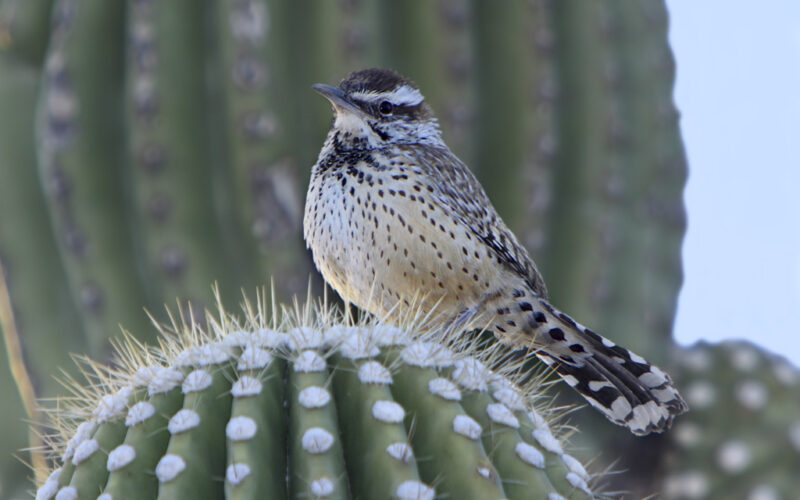
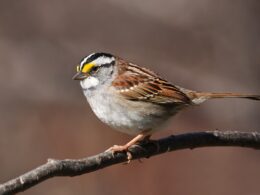
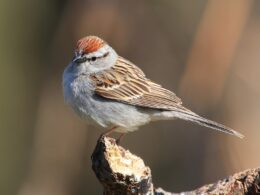
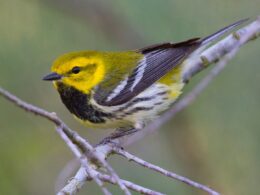
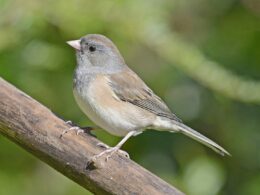
Thank you very much! I found the article informative and a pleasure to read. Also I will be checking out your links you have. Again thank you very much.
Nice job on the article, Greg. I'm in Casa Grande, and found the species that I see regularly here in my backyard. Cactus Wrens, House Finches, Gila Woodpeckers and many other during November. They congregate at my bird-bath, drinking often. My favorites are the Anna's & Costa's Hummers, that I feed nectar to all-year long. Watching them closely brings peace & contentment to the soul, as they are such beautiful creatures…
You are welcome.
Yes, Desertrose, peace and contentment. That's just what we need!
I'm so glad that the article matched your own backyard birds.
Thank you for your kind words!
You should probably add kildeer, I think that's the name. Forgive me, I am not so good at this,but have those in my yard year round.
Killdeer is usually a wetlands or grassland bird. Or golf course! I assume you have a large irrigated lawn, or are next to such.
I have spotted Western Tanager in my backyard in Chandler
Aren't they amazing? Wonderful!
Very informative article. I’ve been feeding & watching my crew for around 4 years. Mostly doves are my ground feeders all types. Finchs & sparrows are the cute ones to watch at my suet & seed hanging feeders. They squabble & dive bomb each other. I quit the suet to much $$ & make them a great value peanut butter & honey sandwich. Occasional humming birds green & black ones. Rare wood pecker & a cardinal that was sick looking but over time got healthy & left. Gackles & a long beak visit quickly. Had cow bird for a while & towhee on occasions. If a pigeon lands I holler- pigeons are not allowed. Over time they got the hint. When I do holler at one the feeding doves don’t fly off, guess they’re used to me. Thanks for the article much appreciated.
You are welcome.
Sounds like you are enjoying your birds!
I thoroughly enjoyed reading about our Arizona birds, and those that visit us annually. Thank you for sharing your knowledge. You are appreciated.
Thank you, Sheryl!
Wonderful, informative article. Thanks so much for sharing!
Thank you.
I have a small bird about the size of a sparrow or house finch. Brown wings but very dark black throat/breast patch. I don't see a match for it here. Any ideas? North Phoenix.
I have a black colored bird with a little bit of white on his wings. He has a very sweet suttle song. Can you tell me the name of this bird? He comes every year and sits on the same very high limb of a tree in my yard. There are a few others of this same species around also.
These are Phainopeplas, if I am understanding you correctly. They winter in large numbers in the desert, spread out into the foothills in summer. They are number 24 in the list of birds in this article.